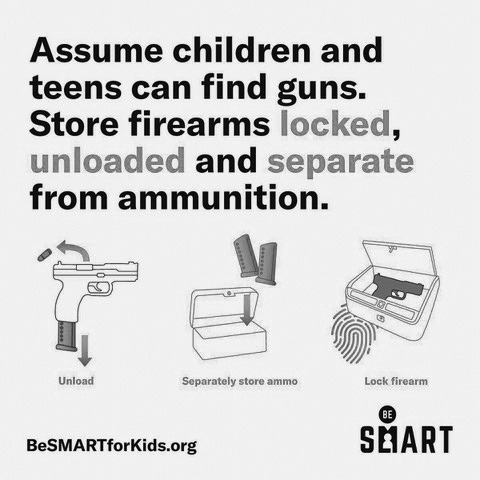It’s a devastating truth: firearms are the leading cause of death among U.S. children and teens. In 2023, more than 2,500 youth, age 17 and under, died from gunshot wounds, and many more were injured. While these facts are heartbreaking, there is hope. Every community member can make a difference, whether you’re a parent, grandparent, family member, friend, gun owner or non-gun owner.
Last week, I introduced information from Be SMART, a secure firearm storage program designed to help keep kids safe.
The first step in the SMART framework is: S: Secure guns in homes and vehicles.
Research shows most unintentional shootings and firearm suicides among children happen in their own home.

A U.S. Secret Service study also found that 76 percent of school shooters under 18 obtained their guns from a parent or close relative. Simply put: secure storage in both homes and vehicles can prevent tragedies.
It’s important to understand that hiding a gun is not the same as securing it. Storing firearms under a seat, in a central console, or glove compartment increases the risk a curious child will access it and also increases the risk of gun theft. More than half of stolen guns are taken from vehicles, which can increase crime and gun violence in our community.
Fortunately, many secure storage options exist for vehicles that will prevent access by children and deter theft.
M: Model Responsible Behavior
Kids are curious. The Be SMART program teaches that it is always an adult’s responsibility to prevent unauthorized access to firearms, not a child’s responsibility to avoid guns.
Studies show nearly 40 percent of parents are unaware that their children know where guns are stored in the home.
Many adults assume children won’t touch a firearm if they’ve been taught not to, often because that’s how they were raised.
But research tells a different story.
In a 2002 study, children ages 4 to 7 were either given a week-long gun safety course or no training at all. When placed in a room with a disabled handgun, more than half of the children in both groups handled the gun.
A 2019 systematic review in Health Promotion Practice (Holly et al.
730) concluded that gun safety programs do not improve the likelihood that children will not handle firearms in an unsupervised situation.
Gun safety conversations are important whether you own firearms or not, but they should be treated as a precaution, not a guarantee. That’s why we need both: secure storage and age appropriate education.
The American Academy of Pediatrics recommends teaching children that if they find a gun, even one that looks like a toy, that they should stop, not touch it, and tell a grown-up.
These messages should be repeated often, with more detail as children grow. Resources from Be SMART and the AAP can help guide these conversations, or you can ask your child’s pediatrician for support.
A: Ask About Unsecured Guns in Other Homes Over one-third of unintentional shootings occur in the homes of relatives, friends or neighbors. Most parents already ask safety questions before visits like, “Who will be there?”, “Do you have a pool?” or “My child has a peanut allergy.” It’s time to add, “Do you have any unsecured firearms in your home?”
Remember, 4.6 million children live in homes with at least one loaded, unlocked gun – and that doesn’t include homes they may visit, like the home of a grandparent or a family friend.
This allows non-gun owners and responsible gun owners to both say “no.” If the answer is “yes,” you can follow up and make an informed decision for your child. If asking in person feels awkward, try a text or email. The more we normalize this conversation, the easier it becomes.
Even for grandparents or others who don’t regularly have children at their home, this is a chance to review storage practices and play a role in keeping kids safe.
Asking about secure storage is a simple, powerful way to protect children, and a step every adult can take.






